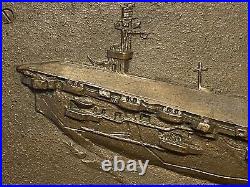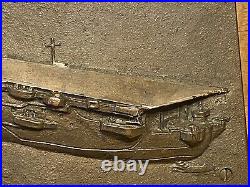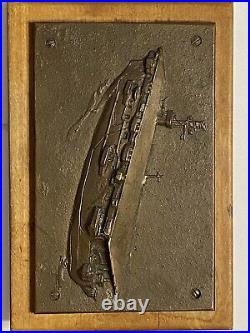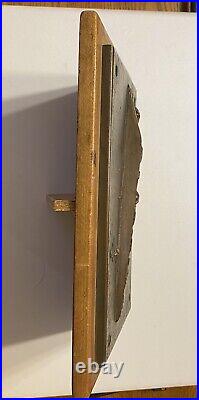












HMS Glorious Aircraft Carrier HEAVY (4 and 1/2 pounds Total) Brass Plaques VERY VERY RARE!! CONDITION: Excellent Used Condition, small water stain on the upper right-hand corner of the wood frame, a couple of dings on the decks right edge. See pics for a better description and condition. Measures: 9″ x 6″ x 1 (including wood back frame). HEAVY (4 and 1/2 pounds Total) Brass Plaques, see pics. My pics are a big part of my description and condition, please look them all over carefully. HISTORY: Late in the afternoon of June 8th, 1940, the Royal Navy suffered one of its most devastating defeats of the Second World War. HMS Glorious, one of Britain’s largest and fastest aircraft carriers, was sunk along with her escorting destroyers HMS Ardent and HMS Acasta. The three British warships were taking part in Operation Alphabet, the evacuation of Allied forces from Norway that had been taking place simultaneously with the rather better known and remembered evacuation at Dunkirk. At 0300, Glorious and her escorts detached from Vice Admiral Lionel Wells’ aircraft carrier squadron, which was covering the evacuation convoys on their journey back to Britain, and headed home. She had been assigned to evacuate ten biplane Gloster Gladiator fighters of the RAF’s 263 Squadron. In a remarkable feat of seamanship and flying, seven Hawker Hurricanes of 46 Squadron also managed to land on her flight deck: something previously thought impossible for high performance monoplanes, unadapted to naval work. At 1545 they were spotted by the German battleships Scharnhorst and Gneisenau. With no aircraft in the air to provide an early warning, and despite a heroic, Victoria Cross-nominated defensive performance by the destroyers, escape proved impossible. Some 900 men went into the cold, northern waters that evening and they faced a horrifying ordeal. Hour after hour men waited in the water and in open rafts as their shipmates slipped away around them. When Norwegian vessels finally found them nearly three days later, only 40 remained alive. The death toll of 1,519 exceeded any of the other great British naval disasters of the war. Among the dead was Glorious’ Captain, Guy D’Oyly-Hughes, a highly decorated submariner whose First World War record was legendary. One of the Royal Navy’s precious few large aircraft carriers had been sunk, along with two destroyers and, with the Battle of Britain in the offing, two RAF fighter squadrons. The Admiralty Board of Enquiry was held within days of the 34 available survivors returning to Britain, its findings then sealed until 2041. Controversy began almost immediately, with questions first being asked in Parliament on the July 31st, 1940 culminating in a debate on November 7th. Richard Stokes, a noted critic of the government, was prime mover, asking just how and why such an epic disaster could have occurred and who bore responsibility. Inevitably, given wartime exigencies, no answers were forthcoming from the Admiralty. The war moved on and the issue went quiet for some years until in 1946, after further probing from Stokes, a brief official account was released. First to contradict this was no less a personage than Winston Churchill, who wrote in his account of the war that the fuel explanation was’not convincing’. Nonetheless, the official story held for the next 30 years through the publication of the official histories. Yet it would be the Navy’s official historian, Captain Stephen Roskill, who in 1980 finally lifted the lid on the controversy in an explosive article for the Sunday Times. The Cantankerous Captain of HMS Glorious’ drew upon testimony from Captain J. Heath, Glorious’ senior aviator, who had missed the sinkings due to having been put ashore before she sailed for the final time. Also steaming home independently, Devonshire was carrying the Norwegian royal family to safety in Britain. Officially, she received only a corrupted message from Glorious and maintained radio silence until the following day, passing it on when its significance became clear. Devonshire’s signal logs did not survive, but changes in course and speed, a main armament drill at the time of the sinking, plus testimony from veterans of her crew to the documentary crew all suggested that Glorious’ message may not have been so corrupted after all. Thus, questions began to be raised over whether the crews of Glorious and her escorts had in some respects been sacrificed to protect Devonshire and the Norwegian royal family. This opened another round of questions in Parliament, most notably from Tam Dayell, and a seven-page official response from the Ministry of Defence entitled H. Glorious – Points of Controversy, which broadly restated the Admiralty’s original case, particularly over the fuel and radio issues. Moreover, with seemingly little resolved between the official and other accounts of the sinkings, and public interest in the Second World War remaining high, it seems certain that we have yet to hear the last of this tragic, controversial episode. This item is in the category “Collectibles\Militaria\WW II (1939-45)\Reproductions\Great Britain”. The seller is “goldenruletraders” and is located in this country: US. This item can be shipped to United States.
- Country/Region of Manufacture: United Kingdom
